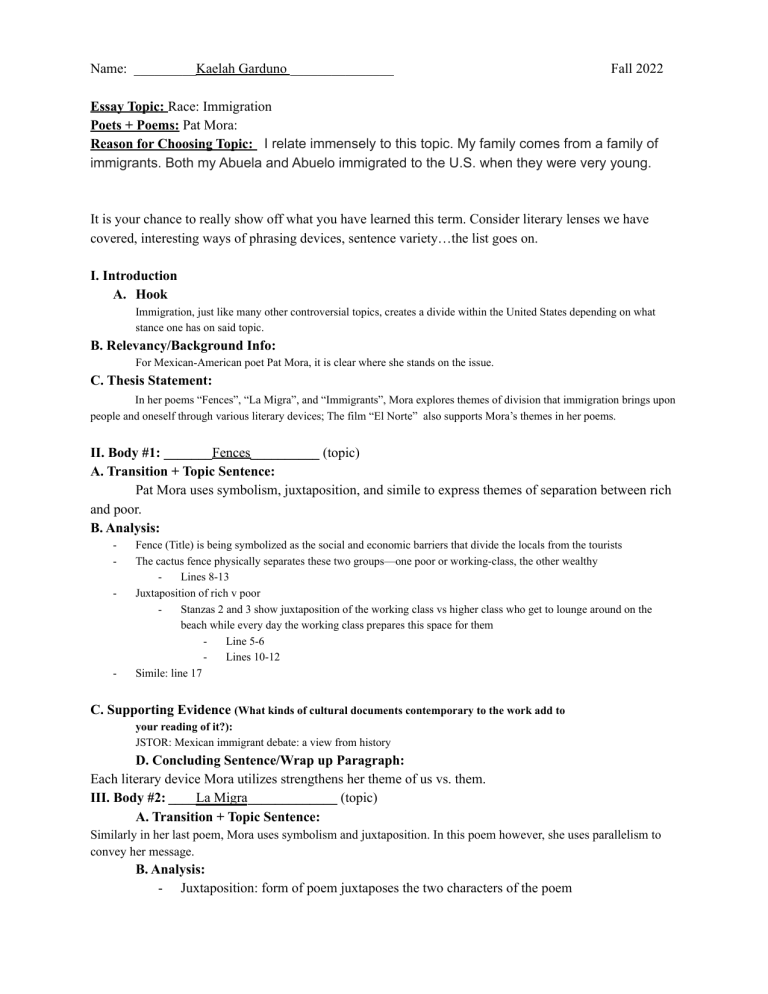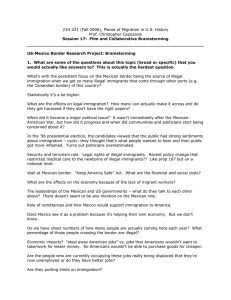
Name: _________Kaelah Garduno _______________ Fall 2022 Essay Topic: Race: Immigration Poets + Poems: Pat Mora: Reason for Choosing Topic: I relate immensely to this topic. My family comes from a family of immigrants. Both my Abuela and Abuelo immigrated to the U.S. when they were very young. It is your chance to really show off what you have learned this term. Consider literary lenses we have covered, interesting ways of phrasing devices, sentence variety…the list goes on. I. Introduction A. Hook Immigration, just like many other controversial topics, creates a divide within the United States depending on what stance one has on said topic. B. Relevancy/Background Info: For Mexican-American poet Pat Mora, it is clear where she stands on the issue. C. Thesis Statement: In her poems “Fences”, “La Migra”, and “Immigrants”, Mora explores themes of division that immigration brings upon people and oneself through various literary devices; The film “El Norte” also supports Mora’s themes in her poems. II. Body #1: _______Fences__________ (topic) A. Transition + Topic Sentence: Pat Mora uses symbolism, juxtaposition, and simile to express themes of separation between rich and poor. B. Analysis: - - Fence (Title) is being symbolized as the social and economic barriers that divide the locals from the tourists The cactus fence physically separates these two groups—one poor or working-class, the other wealthy Lines 8-13 Juxtaposition of rich v poor Stanzas 2 and 3 show juxtaposition of the working class vs higher class who get to lounge around on the beach while every day the working class prepares this space for them Line 5-6 Lines 10-12 Simile: line 17 C. Supporting Evidence (What kinds of cultural documents contemporary to the work add to your reading of it?): JSTOR: Mexican immigrant debate: a view from history D. Concluding Sentence/Wrap up Paragraph: Each literary device Mora utilizes strengthens her theme of us vs. them. III. Body #2: ____La Migra_____________ (topic) A. Transition + Topic Sentence: Similarly in her last poem, Mora uses symbolism and juxtaposition. In this poem however, she uses parallelism to convey her message. B. Analysis: - Juxtaposition: form of poem juxtaposes the two characters of the poem - - Symbolism: The desert, as a location and as a symbol, plays an important role. She describes the desert as a nurturing force for people of Mexican origin who live near the US border or must cross it by foot. Undocumented migrants respect and adore nature, which is why it defends them and feels their plight. In this poetry, the regard for nature displayed by border crossers contrasts sharply with the disrespect displayed by the Border Patrol for both the migrants and the bounds of his own power. - (Lines 27-29). Parallelism: Both stanzas have similar beginning and ending. The Mexican woman and the border patrol are given their respective contestant roles. The poem's situation, or the "game," appears to be ongoing, and the repetition suggests that many people have taken on these roles at various points in time. - Lines 1, 19 - Lines 2 and Line 21 C. Supporting Evidence (What kinds of cultural documents contemporary to the work add to your reading of it?): JSTOR: La Frontera: The Border as Symbol and Reality in Mexican-American Thought D. Concluding Sentence/Wrap up Paragraph: The literary devices used in La Migra supplement Mora’s main message of her work. IV. Body #3: ___Immigrants______________ (topic) A. Transition + Topic Sentence: In her last poem, Mora uses enjambment, diction, and synecdoche to draw attention to the identity struggle that Mexican-Americans deal with. B. Analysis: - Enjambment: poem is a run on sentence, ends in a question - Uses enjambment to make readers focus on the question at the end of the poem - Diction: “dark” lines 11-12, line 8 - Synecdoche: Line 1, referring to all immigrant parents trying to make their children fit into American culture C. Supporting Evidence (What kinds of cultural documents contemporary to the work add to your reading of it?): Jstor: MEXICAN IMMIGRATION AND MEXICAN AMERICAN IDENTITIES D. Concluding Sentence/Wrap up Paragraph: Hence, Mora’s application of enjambment, diction and synecdoche in this poem. illustrates the internal battle that immigrants deal with of wanting to keep homeland culture while also trying to enumerate themselves in American culture. V. Body #4: ____El Norte (Film)_______________ (Art Piece) A. Transition + Topic Sentence: The film, “El Norte” supplements Mora’s themes expressed in her work. B. Analysis: - Movie is about immigrating into the Us - Brother and sister, their family is killed by the Guatemalan gov and they are forced to flee to “el Norte” (The north) - First attempt to cross the Mexican border into the US fails - Second attempt they go through the sewage pipes; horrific experience, filled with rats - Finally get into the US but realize how difficult life is w/o documentation - Enrique (brother) becomes busboy, gets promoted, and gets approached by a wealthy business woman with an amazing job offer in Chicago - Enrique doesn’t want to leave sister, eventually takes job, but then Rosa (sister) falls gravely ill w/ typhus from the rat bites - As she’s dying she says, "In our own land, we have no home. They want to kill us. In Mexico, there is only poverty. We can't make a home there either. And here in the north, we aren't accepted. When will we find a home, Enrique? Maybe when we die, we'll find a home." C. Supporting Evidence (What kinds of cultural documents contemporary to the work add to your reading of it?): N/A D. Concluding Sentence/Wrap up Paragraph In closing, Pat Mora’s poems, “Fences”, “La Migra” and “immigrants” as well as the movie “El Norte” all convey themes of immigration and the struggles that come with being an immigrant from below the Mexican-American border in this country. Annotated Bibliography ● Summarize: What are the main arguments? What is the point of this book or article? What topics are covered? If someone asked what this article/book is about, what would you say? The length of your annotations will determine how detailed your summary is. ● Assess: After summarizing a source, evaluate it. Is it a useful source? How does it compare with other sources in your bibliography? Is the information reliable? Is this source biased or objective? What is the goal of this source? ● Reflect: Once you’ve summarized and assessed a source, you need to ask how it fits into your research. Was this source helpful to you? How does it help you shape your argument? How can you use this source in your paper? Has it changed how you think about your topic? Source #1 The Mexican Immigratio n Debate: The View from History Katz, Michael B., et al. “The Mexican Immigratio Summarize Assess An in depth look at the timeline of mexican immigration starting around 1965 when congress made it easier for legal immigration to resume This source is useful. Although it does have some un useful information unrelated to my topic, it does help support the shown division between the working class and the upper class. Gives a timelines of main events Illustrates how mexican immigrants contribute to economy Reflect This source will be helpful in regards to shedding light on the history aspect of immigration as well as how mexican immigrants came to shape up American economy. n Debate: The View from History.” Social Science History, vol. 31, no. 2, 2007, pp. 157–89. JSTOR, http://www. jstor.org/sta ble/402679 36. Accessed 19 Nov. 2022. Source #2 - La Frontera: The Border as Symbol and Reality in Mexican-A merican Thought García, Mario T. “La Frontera: The Border as Symbol and Reality in Mexican-A merican Thought.” Mexican Studies/Est udios Mexicanos, vol. 1, no. 2, 1985, pp. 195–225. JSTOR, - study analyzes “concept of the border in evolution now mexican American thought, commercing with the first great wave of mexican immigrants during the early 20th century” 3 newspapers that were heavily influential bc of their regional as well as political connections I feel as if it may be a useful source. It's quite different than my other sources considering it looks at newspapers as a main topic of the study, but after reading it there may be some useful information i can use to further strengthen my argument. I haven’t made a concrete decision of how I will use this in my argument. However, it did pique my interest and I feel if I give it a few more read-overs, I will be able to utilize it in my paper. https://doi.o rg/10.2307/ 1052036. Accessed 19 Nov. 2022. Source #3 JSTOR: MEXICAN IMMIGRA TION AND MEXICAN AMERICA N IDENTITIE S - Fernández, Lilia. “MEXICA N IMMIGRA TION AND MEXICAN AMERICA N IDENTITIE S.” Journal of American Ethnic History, vol. 32, no. 3, 2013, pp. 78–82. JSTOR, https://doi.o rg/10.5406/j amerethnhis t.32.3.0078. Accessed 17 Nov. 2022. - Source #4 “El Norte” - - - journal article reviewing two sociologists studies on whether/how “Mexican immigrants assimilate, integrate into the country’s fabric and contribute to American society state” Studies show that Mexican Americans are distinct as a social group Form a sense of self in relation to mexican immigrants “Ethnic replenishment” mexican immigrants provide for mexican American ethnicity Mexicans seen as less a part of US mainstream than their social and economic intergration - Movie is about immigrating into the Us I believe this source is useful, it shows how the influx of immigrants keep the immigrants who have established themselves in the US attached to their roots, because the immigrants who have been here longer have tried to fit in with American culture, losing touch of their homeland culture. This source is related to the theme of “Immigrants”; it will be useful in supporting the claims made in the poem. This movie compliments Mora’s themes shown in her work. Although it is not about Mexican Immigration, they do have to cross I watched this movie in Spanish class my freshman year of high school. It resonated with me greatly; I felt true emotion while watching - - - - - Brother and the Mexican-American border and go through the same struggles sister, their Mexican immigrants do. family is killed by the Guatemalan gov and they are forced to flee to “el Norte” (The north) First attempt to cross the Mexican border into the US fails Second attempt they go through the sewage pipes starting in. Mexico and ending in California; horrific experience, filled with rats Finally get into the US but realize how difficult life is w/o documentati on Enrique (brother) becomes busboy, gets promoted, and gets approached by a wealthy business woman with an amazing this film. It portrayed the struggles endured in their home country as well as how difficult it is to immigrate into the U.S., and the hardships that follow. Crossing the border is only the first part of the battle, making a life in this country is the other half. - - job offer in Chicago Enrique doesn’t want to leave sister, eventually takes job, but then Rosa (sister) falls gravely ill w/ typhus from the rat bites As she’s dying she says, "In our own land, we have no home. They want to kill us. In Mexico, there is only poverty. We can't make a home there either. And here in the north, we aren't accepted. When will we find a home, Enrique? Maybe when we die, we'll find a home."


